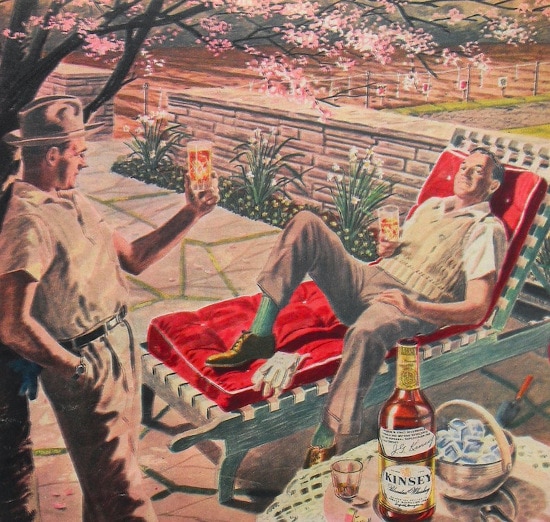
Summer’s blistering temperatures often spur the craving for a refreshing, ice cold beverage. Whether enjoying whiskey or soda, most people want some chill before drinking. How do you go about it, though? The most common method is obviously ice — but what kind of ice is best? Crushed? Cubed? With whiskey, many drinkers don’t want to dilute the drink, and so opt-out of ice altogether in favor of cooling down their spirit with whiskey stones (usually made of soapstone).
It may seem like a simple choice, but the size of the cube actually determines a lot in regards to temperature and how long the drink will stay cold. So which of these methods is the best? What’s the optimal size for ice cubes? No need to experiment for yourselves — we’ve done the legwork for you. Below are the results of my experiment — be cool and read on.
Methodology

I used whiskey for this particular experiment (Russell’s Reserve 10-Year Bourbon, to be exact). Whiskey is stored at room temperature, and while many people don’t chill it, most do. While I used a uniform beverage for this article, I also tested soda (just ice, though, not the stones/balls), and the results were fairly similar. If you’re throwing back some Virgil’s Root Beer, this information is still helpful.
I measured the starting temperature, which in this case was 70 degrees — room temp. I then used 5 different cooling methods, measuring the immediate temperature, then measuring again every half hour for two hours.
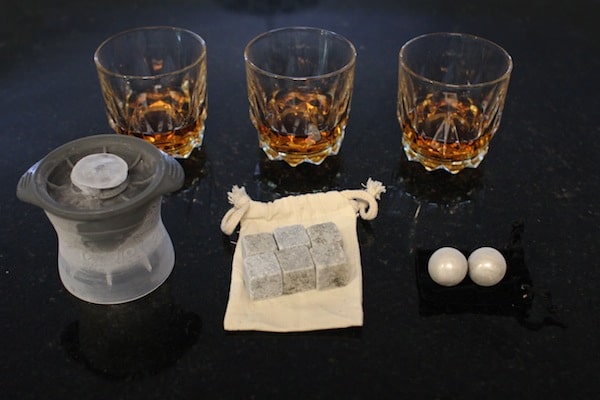
The ice ball, whiskey stones, and stainless whiskey balls.
The cooling methods I used:
- Whiskey stones (made of soapstone)
- Whiskey balls (a stainless steel whiskey “stone”)
- Ice ball (just a single giant ice cube)
- Ice cubes (from a standard refrigerator ice maker or ice tray)
- Crushed ice
I hypothesized that the more surface area a cube had, the faster it would cool the drink, but also the more quickly it would melt. Let’s see if the data bore this theory out.
Whiskey Stones
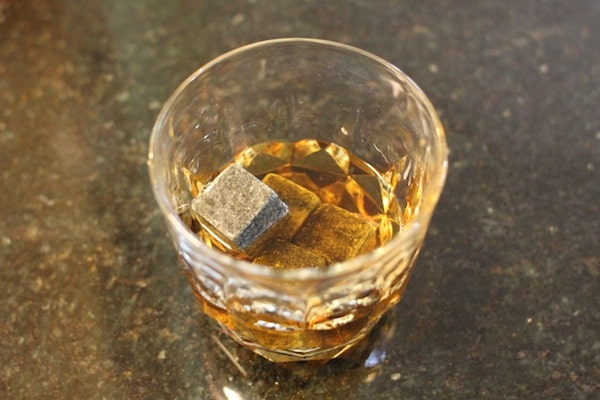
The whiskey stone was first created in the mid-2000s by a company called Teroforma. They quickly caught on with whiskey enthusiasts who wanted to chill but not dilute their drink, and whiskey stones have since been replicated by a number of companies. The idea is that you store the stones in the freezer, and drop a few into your drink when you’re ready to imbibe. I had used whiskey stones before doing this experiment, however, and they hadn’t seemed very effective. Were my senses accurate? Let’s take a look at the data (all numbers are in degrees Fahrenheit):
- Starting temp: 70
- One min after stones added: 62
- After 30 min: 65
- 60 min: 66
- 90 min: 66
- 120 min: 67
So the whiskey stones did indeed chill the drink, without diluting it. Just not by a whole lot; it was only after knowing that the temperature was 8 degrees lower that I actually noticed any change. There’s a good chance it was just my brain, but I suppose the seasoned expert would be able to notice a difference. You can see that after two hours, it was nearly back up to room temperature, which is in line with what most whiskey stone makers will claim.
The other downside is that high-proof whiskies are still a lot to handle without a little bit of dilution. Stranahan’s Whiskey, for instance (a hometown favorite of mine), is intentionally made strong so that consumers can individually dilute the drink to their tastes. Even the founder, Jess Graber, dilutes his whiskey (usually with ice).
Final Verdict: I wasn’t a huge fan of whiskey stones before the experiment, and while they do more than I expected, I’m still not a fan, and probably won’t use them a whole lot.
Whiskey Balls
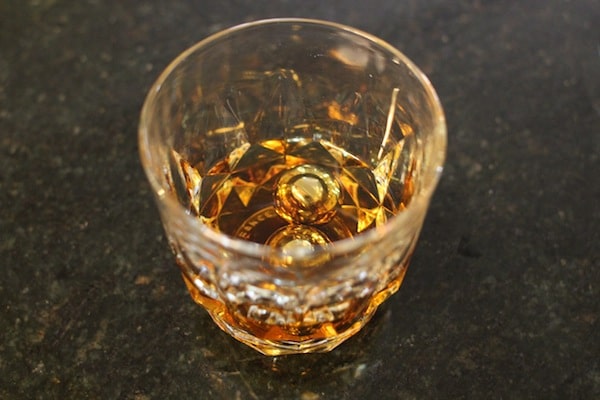
Balls of Steel makes a stainless steel whiskey chiller, setting it apart from the classic soapstone whiskey stone. They have some kind of proprietary chilling technology, and are also lighter in weight than whiskey stones, which they tout as one of their selling points. As with stones, you store them in the freezer until needed, and then pop them in your drink. The disclaimer is that you’re supposed to remove the balls before drinking, but since it’s a sipping beverage, you aren’t likely to accidentally swallow them, and it’s a bit annoying to have to fish them out. Does the steel work any better than the soapstone?
- Starting temp: 70
- One min after balls added: 60
- After 30 min: 60
- 60 min: 64
- 90 min: 65
- 120 min: 65
You can see that the Balls of Steel initially cooled the beverage a little better than the stones. It also held its cool temperature better, but only for the first hour or so. That’s generally enough to finish a drink or two, though, so that’s not much of an issue.
Final Verdict: If you’re going to go with a non-diluting whiskey-chilling product, steel balls are your best choice. They cool a little better and a little longer than soapstone. As a bonus, the company gives 15% of its profits to testicular cancer awareness and research.
Crushed Ice
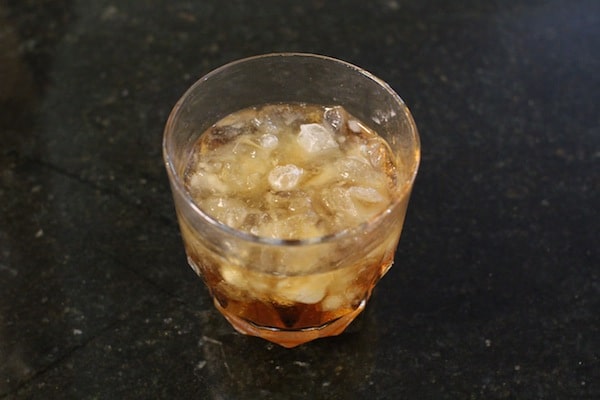
As a kid, I loved crushed ice for some reason. Probably because I could chew it quicker than regular ice cubes (who doesn’t love chompin’ on some ice now and then?). You’ll still sometimes find crushed ice served in whiskey and cocktails at bars (if not actually crushed, then just smaller cubes). How do the smaller cubes hold up to my scientific testing?
- Starting temp: 70
- One min after crushed ice added: 38
- After 30 min: 44
- 60 min: 46 (almost melted)
- 90 min: 49 (totally melted)
- 120 min: 55
You can see that it dropped the temperature of the beverage quite rapidly to start things out, but it very quickly jumped up a little. It obviously melts faster (including some of it nearly right away when pouring in the beverage) than larger ice cubes, meaning the drink stays good for a shorter amount of time, unless you like really watery drinks.
Final Verdict: Crushed ice is fine (not great — just fine) if you’re going to finish your drink in about 20 minutes. After that, even though it’s well chilled, it’s just too watery to enjoy.
Standard Ice Cubes
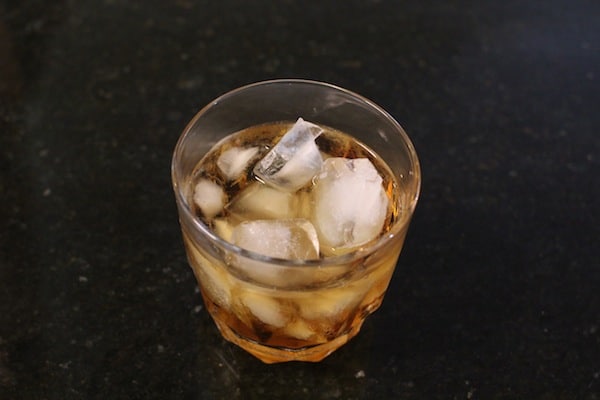
Most people are using normal-sized ice cubes to chill their drinks, be it whiskey or soda. It’s what you get out of ice trays and out of most refrigerators that have an ice maker. It’s also what you’re getting at most restaurants and bars. It may be the most popular method, but is it the most effective?
- Starting temp: 70
- One min after ice cubes added: 35
- After 30 min: 36
- 60 min: 38
- 90 min: 43 (almost melted)
- 120 min: 52 (almost melted)
You can see that the normal ice cubes cooled the drink a bit better than the crushed ice. It also had far greater staying power, taking an hour and a half to reach a temperature that crushed ice got to in 30 minutes.
Final Verdict: You can’t go wrong with a standard ice cube. It’s what is most available, and most likely to be used on a regular basis. I made a note that it got watery at about the 90-minute mark, so you have plenty of time to finish your drink. I actually almost always prefer throwing just a couple normal ice cubes into my whiskey, because it cools the drink just enough, and also provides just enough water for dilution. In addition, it really gives you more control over the final product. Start with one or two ice cubes — if it isn’t cold enough and it’s a bit too strong, just throw in a couple more. Always start with not enough — it’s easier to add ice than take it away (although it is possible if it isn’t all the way melted!).
Ice Ball
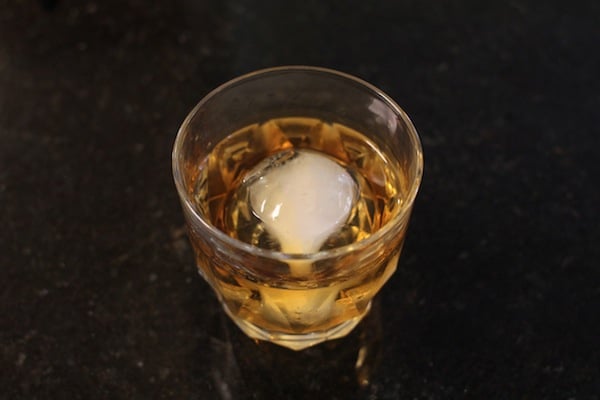
Ah, the glorious ice ball. It’s the newcomer on the ice block, and you often see it at trendy cocktail bars. But you see molds for home use showing up more and more in grocery and liquor stores too. Beyond their fancy presentation, they have less surface area, so theoretically melt much slower, while cooling the drink better. Win-win, right? Let’s find out.
- Starting temp: 70
- One min after ice ball added: 35
- After 30 min: 32
- 60 min: 35
- 90 min: 38 (almost melted)
- 120 min: 49 (totally melted)
The ice ball cooled as well as standard ice cubes, but held that low temperature the longest (even getting cooler, at first). Surprisingly, it melted quicker than the normal-sized ice cubes. It also has a lot of volume — when it’s totally melted, you have a very watery beverage. The other downside is that they simply aren’t very convenient to make. I use the Tovolo molds, which take up a lot of room in the freezer. I only have two molds, which means I can only serve up to two drinks with the ice balls at any given time. There are trays you can use that make giant cubes, which are no different than spheres, other than shape and amount of surface area.
Final Verdict: Has the best the chilling effect for sure. It also has a neat presentation — if you’re serving whiskey (or even just soda), it looks cooler than normal cubes.
Conclusion
As predicted, the crushed ice, because of its greater surface area, melted more quickly than the cubes and the ball, but contrary to my hypothesis, the cubed ice lasted longer than the ball did. The ice ball, which had the least surface area, actually cooled the drink the most (perhaps due to its greater volume), but the differences in temps between the cubes wasn’t very significant. Perhaps you physicists out there can analyze and explain my results (I’m just a simple whiskey-sipping man myself). The whiskey stones and balls are a neat idea, but don’t perform very well.
Thus, for pure enjoyment I still prefer normal cubes: you’re more in control of dilution, the cooling isn’t different enough from other options to even be noticeable for most people, and it’s more convenient in almost every scenario. Let’s raise a glass to the humble, classic cube!
What’s your preferred method for cooling your drinks?


